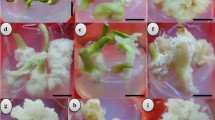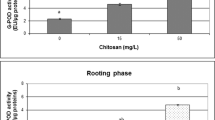Summary
Nucellar calli from two citrus cultivars with known tolerance to mal secco disease were chosen as experimental material, to test the pathogen's response to culture filtrate (CF) and partially purified toxin (PPT). The response of the two calli to the CF was in reverse order to the known response of the two cultivars to natural and artificial inoculations with Phoma tracheiphila. HPLC analysis of P. tracheiphila CF indicated the presence of a relatively high level of indole acetic acid (IAA). The response of the two calli and protoplasts derived from these calli to increasing amounts of IAA in the culture media was in the same order as that of calli and protoplasts to CF. In contrast, the responses to PPT of calli and protoplasts from these two types confirmed the relative tolerance of ‘Femminello’ lemon and ‘Tarocco’ orange trees to mal secco disease.
Similar content being viewed by others
References
Barash I, Pupkin G, Koren L, Ben-Hayyim G (1981) A low molecular weight phytotoxin produced by Phoma tracheiphila, the cause of mal secco disease in citrus. Physiol Plant Pathol 19:17–29
Barendse GWM (1987) High performance liquid chromatography of gibberellins. In: Linskens HF, Jackson JF (eds) High performance liquid chromatography in plant science. Modern methods of plant analysis, Vol. 5. Springer, Berlin, pp1–22
Brian PW, Elson GW, Hemming HG, Badley M (1954) The plant growth promoting properties of gibberellic acid, a metabolic product of the fungus Gibberella fujikuroi. J Sci Food Agric 5: 601–612
Catara A, Cutuli G (1972) Osservazioni sulla suscettibilita' di alcune rutacee alle infezioni epigee di Phoma tracheiphila. Ann Ist Sper Agrumic Acireale 5:29–43
Chen Ch-M (1987) Characterization of cytokinin and related compounds by HPLC. In: Linskens HF, Jackson JF (eds) High performance liquid chromatography in plant science. Modern methods of plant analysis, Vol. 5. Springer, Berlin pp 22–38
Daub ME(1986) Tissue culture and the selection of resistance to pathogens. Annu Rev Phytopathol 24:159–186
Earl ED, Gracen VE, Yoder OC, Gemmill KP (1978) Cytoplasm-specific effects of Helminthosporium maydis race T toxin on survival of corn mesophyll protoplasts. Plant Physiol 61:420–424
Epstein E, Miles PG (1967) Identification of indole-3-acetic acid in the basidiomycete Schizophyllum commune. Plant Physiol 10:405–440
Gruen H (1959) Auxins and fungi. Annu Rev Plant Physiol 10:405–440
Hammerschlag FA (1988) Selection of peach cells for insensitivity to culture filtrate of Xanthomonas campes tris pv pruni and regeneration of resistant plants. Theor Appl Genet 76:865–869
Hammerschlag FA (1990) Resistance response of plants regenerated from peach callus to Xanthomonas campestris pv pruni. J Am Soc Hortic Sci 115:1034–1037
Hartman CL, McCoy TJ, Knons TR (1984) Selection of alfalfa (Medicago sativa) cell lines and regeneration of plants resistant to the toxin(s) produced by Fusarium oxysporum f. sp. medicaginis. Plant Sci Eett 34:183–194
Johnston JC, Trione EJ (1974) Cytokinin production by the fungi Taphrina cerasi and Taphrina deformans. Can J Bot 52:1583–1589
Kochba J, Spiegel-Roy P, Saad S (1980) Selection for tolerance to sodium chloride (NaCl) and 2,4-dichlorophenoxy-acetic acid (2,4-D) in ovular callus lines of Citrus sinensis. In: Sala F, Parisi B, Cella R, Ciferri O (eds) Plant cell cultures: results and perspectives. Elsevier/North-Holland Biochemical Press, Amsterdam, pp 187–192
Ling DH, Vidhyaseharan P, Borromeo ES, Zapata FJ, Mew TW (1985) In vitro screening of rice germplasm for resistance to brown spot disease using phytotoxin. Theor Appl Genet 71:113–135
Lowry OH, Rosebrough NJ, Farr AL, Randall RJ (1951) Protein measurement with the Folin phenol reagent. J Biol Chem 193:265–275
Murashige T, Tucker DPH (1969) Growth factor requirements of Citrus tissue culture, Vol. 3. In: Chapman HD (ed) Proc 1st Int Citrus Symp, Riverside/CA, pp 1155–1161
Nachmias A, Barash I, Solei Z, Strobel GA (1977a) Translocation of mal secco toxin in lemons and its effect on electrolyte leakage, transpiration and citrus callus growth. Phytoparasitica 5:94–103
Nachmias A, Barash I, Solel Z, Strobel GA (1977b) Purification and characterization of phytotoxin produced by Phoma tracheiphila, the causal agent of mal secco disease of citrus. Physiol Plant Pathol 10:147–157
Nachmias A, Barash I, Buchner V, Solel Z, Strobel GA (1979) A phytotoxic glycopeptide from lemon leaves infected with Phoma tracheiphila. Physiol Plant Pathol 14:135–140
Nachmias A, Barash I, Solel Z, Strobel GA (1980) Effect of mal secco toxin on lemon leaf cells. Phytoparasitica 8:51–60
Pennisi AM, Di Pasquale G, Bonforte M, Sesto F (1988) Phytotoxic metabolites of ipo-virulent and virulent Phoma tracheiphila isolates. Proc 6th Int Citrus Congr 2:817–827
Perrotta G, Tribulato E (1977) Observation on the susceptibility of nucellar lines of lemon to mal secco disease in Sicily. Proc Int Soc Citriculture 3:1004–1005
Perrotta G, Magnano di San Lio G, Lo Giudice L, Bassi M (1978) Ultrastructural modifications induced by Phoma tracheiphila in sour orange. Riv Patol Veget 14:25–31
Sacristan MD (1982) Resistance response to Phoma lingam of plants regenerated from selected cell and embryogenic cultures of haploid Brassica napus. Theor Appl Genet 61:193–200
Salerno M, Cutuli G (1977) Control of citrus and mal secco in Italy today. Proc Int Soc Citriculture 3:1001–1003
Sandberg G, Crozier A, Ernsten A, Sundbery B (1987) High performance liquid chromatography and the analysis of indole-3-acetic acid, and some of its decarboxylated catabolites in Scots pine (Pinus sylvestris L.). In: Linskens HF, Jackson JF (eds) High performance liquid chromatography in plant science. Modern methods of plant analysis, Vol. 5. Springer, Berlin, pp 72–91
Sesto F, Grimaldi V, Pennisi AM (1990) Sensitivity of different citrus and non-citrus species protoplasts towards mal secco toxins. Adv Hortic Sci 4:97–102
Sjodin C, Glimelius K (1988) Screening for resistance to blackleg Phoma lingam (Tode ex Fr.) Desm. within Brassicaceae. J. Phytopathol 123:322–332
Sjodin C, Glimelius K (1989) Differences in response to the toxin sirodesmin PL produced by Phoma lingam (Tode ex FM.) Desm. on protoplasts, cell aggregates and intact plants of resistant and susceptible Brassica accessions. Theor Appl Genet 77:76–80
Sjodin C, Njhammar T, Glimelius K (1988) Effects of toxic metabolites produced by Phoma lingam (Tode ex Fr.) Desm. on protoplasts, cells and plants of hosts and non-hosts of the pathogen. Physiol Mol Plant Pathol 32:301–312
Vardi A, Galun E (1988) Recent advances in protoplast culture of horticultural crops: Citrus. Sci Hortic 37:217–230
Vardi A, Galun E (1989) Isolation and culture of citrus protoplasts. In: Bajaj YPS (ed) Biotechnology in agriculture and forestry, Vol. III. Springer, Berlin, pp 147–159
Vardi A, Raven D (1976) Cross-feeder experiments between tobacco and orange protoplasts. Z Pflanzenphysiol 78:350–359
Vardi A, Spiegel-Roy P, Galun E (1982) Plant regeneration from Citrus protoplasts: variability in methodological requirements among cultivars and species. Theor Appl Genet 62:171–176
Vardi A, Epstein E, Brieman A (1986) Is the Phytophthora citrophthora culture filtrate a reliable tool for the in vitro selection of resistant Citrus variants? Theor Appl Genet 72:569–574
Widholm JM (1972) The use of fluorescein diacetate and phenosafranine for determining viability of cultured plant cells. Stain Technol 47:189–194
Yoder OC (1980) Toxins in pathogenesis. Annu Rev Phytopathol 18:103–129
Yoder OC (1981) Assay. In: Durbin RD (ed) Toxins in plant disease. Academic Press, New York, pp 45–78
Yoder OC (1983) Use of pathogen-produced toxins in genetic engineering of plants and pathogens. In: Kosuge T, Meredith CP, Hollander A (eds) Genetic engineering of plants. Basic life science, Vol. 26, Plenum Press, New York, pp 335–353
Author information
Authors and Affiliations
Additional information
Communicated by G. Wenzel
Contribution from the Agricultural Research Organization, The Volcani Center, Bet Dagan, Israel. No. 3248-E, 1991 series
Rights and permissions
About this article
Cite this article
Gentile, A., Tribulato, E., Continella, G. et al. Differential responses of citrus calli and protoplasts to culture filtrate and toxin of Phoma tracheiphila . Theoret. Appl. Genetics 83, 759–764 (1992). https://doi.org/10.1007/BF00226695
Received:
Accepted:
Issue Date:
DOI: https://doi.org/10.1007/BF00226695




